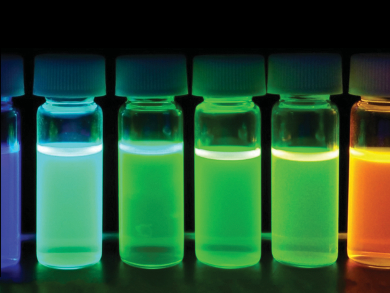Quantum dots (QDs) are nanometer-sized semiconductor materials with highly tunable properties such as bandgap, emission color, and absorption spectrum. These characteristics depend heavily on their size and shape, which can be controlled during the synthesis.
Haibo Zeng, Nanjing University of Science and Technology, China, and colleagues have used quantum dots based on the perovskites CsPbX3 (X = Cl, Br, I) for QD-based light-emitting devices (QLEDs). These completely inorganic materials solve the stability problem of previously developed hybrid organic–inorganic halide perovskites such as CH3NH3PbX3.
The quantum dots’ luminescence wavelength can be tuned by both their size and by the halide ratio. The team made blue, green, and yellow QLEDs with high quantum yields, using the perovskite quantum dots as the emitting layer. The researchers state that this development could allow the design of new optoelectronic devices, such as displays, photodetectors, solar cells, and lasers.
- Quantum Dot Light-Emitting Diodes Based on Inorganic Perovskite Cesium Lead Halides (CsPbX3),
Jizhong Song, Jianhai Li, Xiaoming Li, Leimeng Xu, Yuhui Dong, Haibo Zeng,
Adv. Mater. 2015.
DOI: 10.1002/adma.201502567




